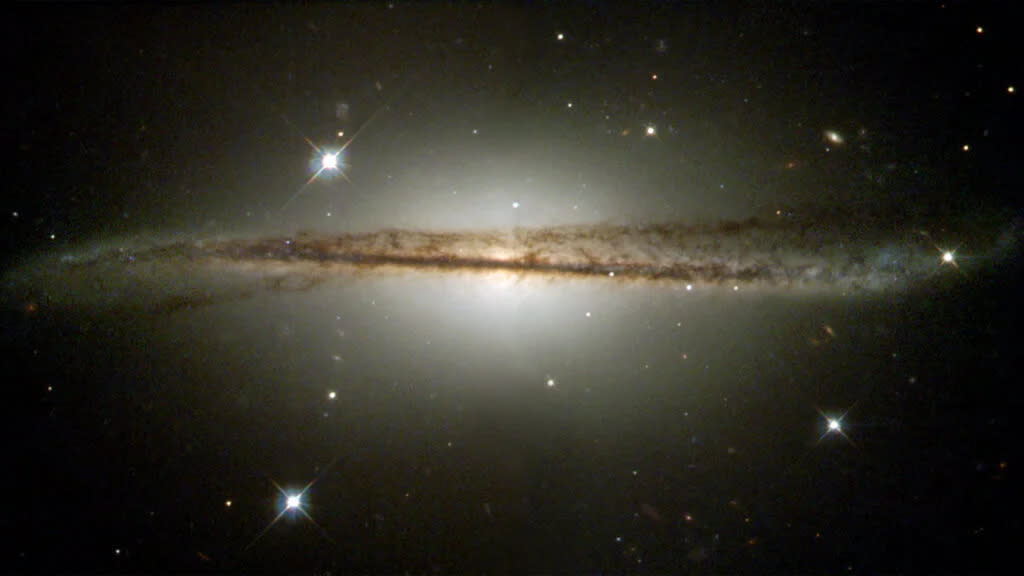The Milky Way is warped, and it might be the work of dark matter

The Milky Way is twisted, and astronomers may finally know why. They're laying the blame on a football-shaped, tilted halo of dark matter that envelopes our galaxy.
The common image of our galaxy resembles a flattened disk similar to a vinyl record, but what you might not imagine is the flared skirt at its edge structured like the outer ring of a frisbee. And when scientists have studied the shape of the Milky Way in great detail, they found the disk of our spiral galaxy to also have a warp, meaning it's a bit closer to a frisbee twisted and bent by an angry child.
These features have remained sort of mysterious for quite a while, but now, astronomers from the Center for Astrophysics | Harvard and Smithsonian (CfA) have performed calculations that indicate the halo of dark matter enveloping the Milky Way could be "off-kilter," and this could be causing the flared edge and warped shape of our galaxy.
Not only might this revelation help us better understand the evolution of the Milky Way, but it could also reveal more about the nature of dark matter and how it shapes the overall development of galaxies.
Related: Astronomers weigh ancient galaxies’ dark matter haloes for 1st time
Dark matter is a challenge for scientists to explain because it does not interact with light, making it effectively invisible and meaning it can’t be made of the same atoms that constitute everyday matter. Yet, this mysterious substance makes up as much as 85% of the matter content of the universe, meaning the "stuff" that comprises stars, planets, cosmic clouds of dust and even our bodies — everything we see around us on an everyday basis — only accounts for around 15% of the universe’s matter.
The only way scientists have been able to infer the presence of dark matter is via its interactions with gravity and the influence this has on everyday matter and light. This influence is a fortunate thing, in fact, because galaxies are rotating so utterly fast that, in some cases, the gravitational effect of visible matter within these entities wouldn’t be sufficient to prevent them from flying apart. Dark matter is the gravitational glue that holds galaxies together.
Thus, researchers have deduced that most, if not all, galaxies are wrapped in a halo of dark matter. And for the Milky Way, that halo of dark matter is thought to extend out past the halo of stars surrounding the galaxy's main disk and central galactic nucleus.
Last year, the same Harvard team was able to calculate the Milky Way’s stellar halo to hold an elliptical or football-like shape, angled at a tilt relative to the galaxy's main disk. The researchers had, at that time, inferred that the shape of that dark matter halo would be similar to the stellar halo (with a matching tilt) albeit much wider.
The team has now built upon that inference by using computer models to calculate that the orbit of those stars fits within a tilted, football-shaped dark matter halo. This turned out to be a near-perfect match of the Milky Way with its flared edge and its warp.
"A tilted dark halo is actually fairly common in simulations, but no one had explored its effect on the Milky Way," Charlie Conroy, study team member and a professor of astronomy at the CfA, said in a statement. "It turns out that the tilt is an elegant way to explain both the magnitude and direction of our galaxy’s wobbly disk."
RELATED STORIES:
— The Milky Way's 'fountain of youth' is made of forbidden stars and water ice
— Our Milky Way galaxy was not always a spiral. Here's how it changed shape
— A galactic crash could be behind Milky Way's warped appearance
The team’s findings also support the idea that the Milky Way has grown as a result of collisions with other galaxies.
"If the galaxy was just evolving on its own, it would have had this nice, spherical halo; this nice, flat disk," Jiwon Jesse Han, study team leader and a scientist affiliated with the CfA, said. "So the fact that the halo is tilted and has a football-like shape suggests that our galaxy experienced a merger event, where two galaxies collide."
Calculating the shape of the dark matter disk around the Milky Way could reveal more than the evolutionary story of our galaxy, however — it could also shed light on the nature of dark matter by revealing some of the properties of the particles that make up this strange substance that dominates our universe. The findings could also help astronomers study free-floating "blobs" of dark matter that are thought to drift between galaxies.
"The fact that the galaxy is not spherical in our data implies that there is some limit to which dark matter can interact with itself," Han concluded.
The team’s research was published last month in the journal Nature Astronomy.

